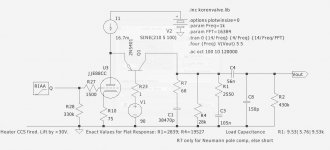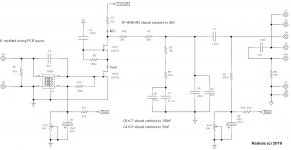They were very popular in the '80s, but the reality is, they don't bring a lot of advantages to the table other than Miller reduction (at the expense of less than optimum noise performance) for the additional complication. And the FET-on-bottom versions work quite well, so...
I suspect a better one could be done than in the past, but there are easier and good-performing ways to accomplish the same goals.
I suspect a better one could be done than in the past, but there are easier and good-performing ways to accomplish the same goals.
IME, a valve in the top of the cascode neither measures nor sounds as good as a BJT. Even a clumsy, high capacitance BU508 TV Line output NPN nails the cascode voltage much better, and sounds distinctly better than even purpose built cascode triodes, like ECC88.
On the bottom, the question is noise. You may be able to make something quiet enough for MM, or MC + step-up trafo, but direct-to-MC is not really practical, if even possible at all.
For MC, the 2SK369 NJFET [or its relatives] shunt-cascoded with a PNP, and a triode second stage, [also shunt-cascoded in my design] give the best performance of anything I've tried.
Perfectly quiet with 0.7mV pk Lyras, amazingly resistant to EMI, very high gain, and splendid sounding.
On the bottom, the question is noise. You may be able to make something quiet enough for MM, or MC + step-up trafo, but direct-to-MC is not really practical, if even possible at all.
For MC, the 2SK369 NJFET [or its relatives] shunt-cascoded with a PNP, and a triode second stage, [also shunt-cascoded in my design] give the best performance of anything I've tried.
Perfectly quiet with 0.7mV pk Lyras, amazingly resistant to EMI, very high gain, and splendid sounding.
You need to think of a cascode as essentially a pentode without partition noise. This is good for RF, but has very little benefit for audio where noise is dominated by 1/f or flicker noise. The reduction in Miller capacitance is helpful, but some MM cartridges (e.g. Ortofon) need more capacitance anyway.
I was at one time thinking about a valve cascode preamp, but when I realised that it has poor PSRR and may need a higher supply voltage I went off the idea.
I was at one time thinking about a valve cascode preamp, but when I realised that it has poor PSRR and may need a higher supply voltage I went off the idea.
............. but when I realised that it has poor PSRR and may need a higher supply voltage I went off the idea.
This is also true, but only in the case of a series cascode.
For a shunt cascode, the PSRR is better than most available alternatives, and the gain and output impedance can be traded off at will, since the dc operating point is not influenced detrimentally. And the fact that both input and output are directly ground-referred, gives high immunity to conducted and EM-coupled noise.
How does shunt cascode improve PSRR? The second/'upper' valve still has a high anode impedance.
Shunt Cascode can't use a valve on the first floor, unless someone developed a P-channel thermionic FET while I've been away.
The schematic shows the basic connexion:
Use your favourite current source [depletion FET, BJT twin, etc] to supply current into the stage. Naturally, the CCS should be designed to heighten the HF insertion loss between supply and amplifying parts.
Then, the cascoding element [PNP BJT] pins the anode of the amplifying device to the working voltage. The combination of these elements presents high dynamic impedance to the +ve supply, while rigidly holding the operating voltage to a ground-referred reference.
The PSRR is excellent, and unbeatable if you take good care in the generation of he cascode voltage (shunt regulator, to ride first class).
Stages built like this can have huge gain (my 300B driver has x280, with 27K output resistor) or can use low value resistor, and drive cables.
In the RIAA stage, you can put all the time constants in the output, and calculate the resistors based on your available C values - you don't have to compromise with the requirements of the load resistor, in the way of the usual valve designs.
Attachments
Hi
Some interesting views on the cascode, i did play around with the shunt or inverted cascode, though quite some years ago, with a very simlar circuit to the one shown, though i used a CCS load for the inverted cascode transistor, fed from a negative supply rail, with riaa eq network tied to ground.
Of course if you take this hybrid aproach one stage further, you are on the slippery slope to a fully solid state design.
Some interesting views on the cascode, i did play around with the shunt or inverted cascode, though quite some years ago, with a very simlar circuit to the one shown, though i used a CCS load for the inverted cascode transistor, fed from a negative supply rail, with riaa eq network tied to ground.
Of course if you take this hybrid aproach one stage further, you are on the slippery slope to a fully solid state design.
Thanks, that makes sense now.Rod Coleman said:The schematic shows the basic connexion:
Member
Joined 2009
Paid Member
All Valve Cascode Phono
I'm wondering if opinions have changed much since this thread was started ?
My interest is in all-valve passive phono and being able to reduce the input capacitance, which from what I've read, is very desirable for MM phono amps. I get the impression that the all-valve cascode has not been used as much as it might. IIRC Merlin has shown how to bias the grid of the upper valve to improve the PSRR too.
I'm wondering if opinions have changed much since this thread was started ?
My interest is in all-valve passive phono and being able to reduce the input capacitance, which from what I've read, is very desirable for MM phono amps. I get the impression that the all-valve cascode has not been used as much as it might. IIRC Merlin has shown how to bias the grid of the upper valve to improve the PSRR too.
I suspect it depends on what sort of circuit you are going for. I've tried an ECC88 cascode in an MM LCR stage (there is a thread a bit back) as you can impedance match an LCR network to the output impedance of the cascode and thereby get more gain out of the stage. For context, the idea was to have an LCR phono using common valves where the existing power supply had 2 30H chokes already in it.
In that context it works well, but I am not sure there are too many other ways it would.
In that context it works well, but I am not sure there are too many other ways it would.
Member
Joined 2009
Paid Member
I am aware that a high gain triode has fairly linear gain, so long as the load is well behaved it is proportional to mu. For a cascode the gain depends on the transconductance of the bottom tube and usually it's not constant with signal level and products dominant 2nd order harmonic distortion. But for first stage of phono where signal levels are small the amplifier 'uses' a very small part of the gm curve. Is this non-linearity a big issue ?
What I am taking away from this thread is that the non-linear load presented by an RIAA network is a problem for the cascode - but isn't that the whole point, that the RIAA loads the amplifier in order to perform it's filtering function ?
What I am taking away from this thread is that the non-linear load presented by an RIAA network is a problem for the cascode - but isn't that the whole point, that the RIAA loads the amplifier in order to perform it's filtering function ?
... as you can impedance match an LCR network to the output impedance of the cascode and thereby get more gain out of the stage.
Cascode is extremely useful in building networks with unusual frequency responses as its output impedance is precisely the load of the upper device.
Here is the example of the MM project I am currently working on, it has been fully prototyped and it set the bar for the quality of a phono preamp for me at a new hight. Using Lipschitz RC correction circuit it produces 0.2dB max deviation in full audio range. Output stage is also a powerful SIT with a choke load.
Attachments
Member
Joined 2009
Paid Member
N
Did you know that Stanley (Lipschitz) lives in town here...
Yep. He just switched sides and seems like spending all his time on attempts to bury Pulsed Code Modulation in digital audio...
Member
Joined 2009
Paid Member
pentode = partition noise and it's entirely avoidable using a cascode.
I'm avoiding sand for the usual irrational reasons - my sand based phono amp is a separate project
cold triodes are a different story, best ask Radiola about that
Read post #4 again.
Member
Joined 2009
Paid Member
ah, just re-read no. 4.Read post #4 again.
is this a public design, that you can link to ?The Daniel is a pretty well-known design that employs passive EQ and a cascode input.
I was thinking of the technique Merlin proposes in his book, of driving the grid of the upper device with a divider off B+ which injects a hum-cancelling amount of rail noise to give a higher PSRR.We've been using a similar idea in our preamps since the late 1980s. But we run our circuits fully differential so as to improve PSRR.
- Home
- Amplifiers
- Tubes / Valves
- Valve cascodes for Phono input.

